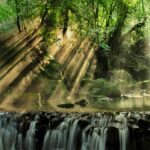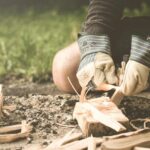Bushcraft, the art of thriving in the wilderness through primitive skills and resourcefulness, has gained popularity in recent years as people seek a deeper connection with nature. However, the rising interest in bushcraft raises important questions about its environmental impact. We’ll explore the delicate balance between enjoying the great outdoors and preserving it for future generations.
Understanding Bushcraft
The Essence of Bushcraft
At its core, bushcraft is about more than just survival; it’s a celebration of our connection to nature. Enthusiasts engage in various activities, from crafting tools from natural materials to building shelters using traditional methods. Bushcraft, much more than a survival skill set, is a profound journey into the heart of our ancestral connection with the wilderness. Let’s delve into the very essence that makes bushcraft a captivating and holistic experience.
1. Back to Basics
At its core, bushcraft strips away the complexities of modern life, returning us to the primal skills and instincts that sustained our forebearers. It’s a rediscovery of the fundamental tools and techniques that define our relationship with the natural world.
2. Nature as a Classroom
Bushcraft isn’t confined to textbooks or classrooms; it’s a hands-on education where nature itself becomes the teacher. The outdoors transform into a living, breathing classroom where every element, from the rustling leaves to the flowing streams, imparts wisdom.
3. Self-Reliance and Empowerment
The essence of bushcraft lies in fostering self-reliance. By acquiring the ability to source food, build shelter, and navigate the terrain, practitioners empower themselves with a profound sense of independence that transcends the ordinary.
4. Cultural Connection
Beyond survival skills, bushcraft is a celebration of cultural heritage. It embodies the wisdom passed down through generations, reflecting the diverse techniques and practices that different cultures developed to thrive in their unique environments.
5. Mindful Living
In the hustle of modern life, bushcraft offers a respite—an opportunity to slow down, observe, and appreciate the present moment. It encourages a mindful approach to living, fostering a deeper connection with both the self and the natural surroundings.
6. Adaptability in Adversity
The essence of bushcraft lies in adaptability. It’s not just about thriving in optimal conditions but also about navigating challenges with resilience. Bushcraft equips individuals with the mental fortitude to face adversity head-on.
7. Environmental Stewardship
Bushcrafters inherently understand their role as stewards of the environment. The essence of this practice includes a commitment to leaving no trace, minimizing impact, and actively participating in the conservation of the ecosystems they engage with.
8. Simplicity Amidst Complexity
In a world marked by technological complexity, the simplicity of bushcraft is refreshing. The essence lies in the elegance of simple solutions to complex problems, reminding us that sometimes, the most effective answers are the most straightforward ones.
9. Connection with Wildlife
Beyond the skill of survival, bushcraft facilitates a unique connection with wildlife. It’s not merely about observing animals; it’s about coexisting harmoniously, respecting their habitats, and understanding the delicate balance of the ecosystem.
10. Personal Growth and Reflection
Lastly, the essence of bushcraft encompasses personal growth. As individuals navigate the challenges of the wild, they also embark on an inner journey—a reflection on their capabilities, limitations, and the profound interconnection between humanity and nature.
In essence, bushcraft is more than a set of skills; it’s a lifestyle that beckons us to rediscover our roots, appreciate the simplicity of existence, and forge a symbiotic relationship with the natural world.
Nurturing Nature
Bushcrafters understand the importance of responsible practices. Unlike other outdoor activities that might leave a significant ecological footprint, the ethos of bushcraft encourages a minimal impact on the environment.
The Eco-Friendly Side of Bushcraft
Leave No Trace Principles
When embracing bushcraft, adhering to the Leave No Trace principles becomes paramount. This philosophy emphasizes responsible outdoor ethics, urging practitioners to leave nature as undisturbed as possible.
Treading Lightly
Bushcrafters strive to minimize their impact by choosing campsites thoughtfully, avoiding unnecessary damage to vegetation, and disposing of waste properly.
Sustainable Practices in Bushcraft
In the pursuit of self-sufficiency, bushcrafters often adopt sustainable practices. This includes foraging for wild edibles, ethically harvesting wood, and using eco-friendly materials for their gear.
Crafting with Care
From choosing biodegradable soaps to opting for gear made from sustainable materials, bushcrafters prioritize items that align with their commitment to environmental stewardship.
Challenges and Controversies
Firecraft Dilemmas
While fire is an essential element in bushcraft, its use can be contentious. Striking a balance between the need for warmth and cooking and the potential impact on the ecosystem is an ongoing challenge.
Controlled Burns
Some bushcrafters advocate for controlled burns as a way to manage vegetation and prevent more catastrophic wildfires. However, critics argue that even controlled burns can disrupt fragile ecosystems.
The Human-Wildlife Interaction
As more people delve into bushcraft, concerns arise about the potential impact on wildlife. Understanding and respecting the natural habitats of animals becomes crucial in maintaining a harmonious coexistence.
Ethical Wildlife Observation
Bushcrafters, as nature enthusiasts, often find themselves in close proximity to wildlife. It is imperative that they adopt ethical practices, ensuring their presence does not disturb or harm the local fauna.
Educating and Advocating for Responsible Bushcraft
Community Building for Conservation
Building a strong community around responsible bushcraft is essential. This involves sharing knowledge, advocating for conservation, and collectively addressing challenges faced in preserving the natural world.
The Role of Bushcraft In Environmental Education
Educating enthusiasts about the delicate balance between enjoying nature and conserving it is crucial. Bushcraft can serve as a powerful tool for environmental education, instilling a sense of responsibility in practitioners.
Conclusion
The environmental impact of bushcraft is a nuanced topic, requiring a delicate balance between the desire to connect with nature and the responsibility to preserve it. By embracing sustainable practices, advocating for conservation, and educating the community, bushcraft can be a force for positive change. As we venture into the wild, let’s remember that our actions today shape the landscapes of tomorrow. Let the spirit of bushcraft be a guide towards harmonizing with, rather than disrupting, the natural world.







